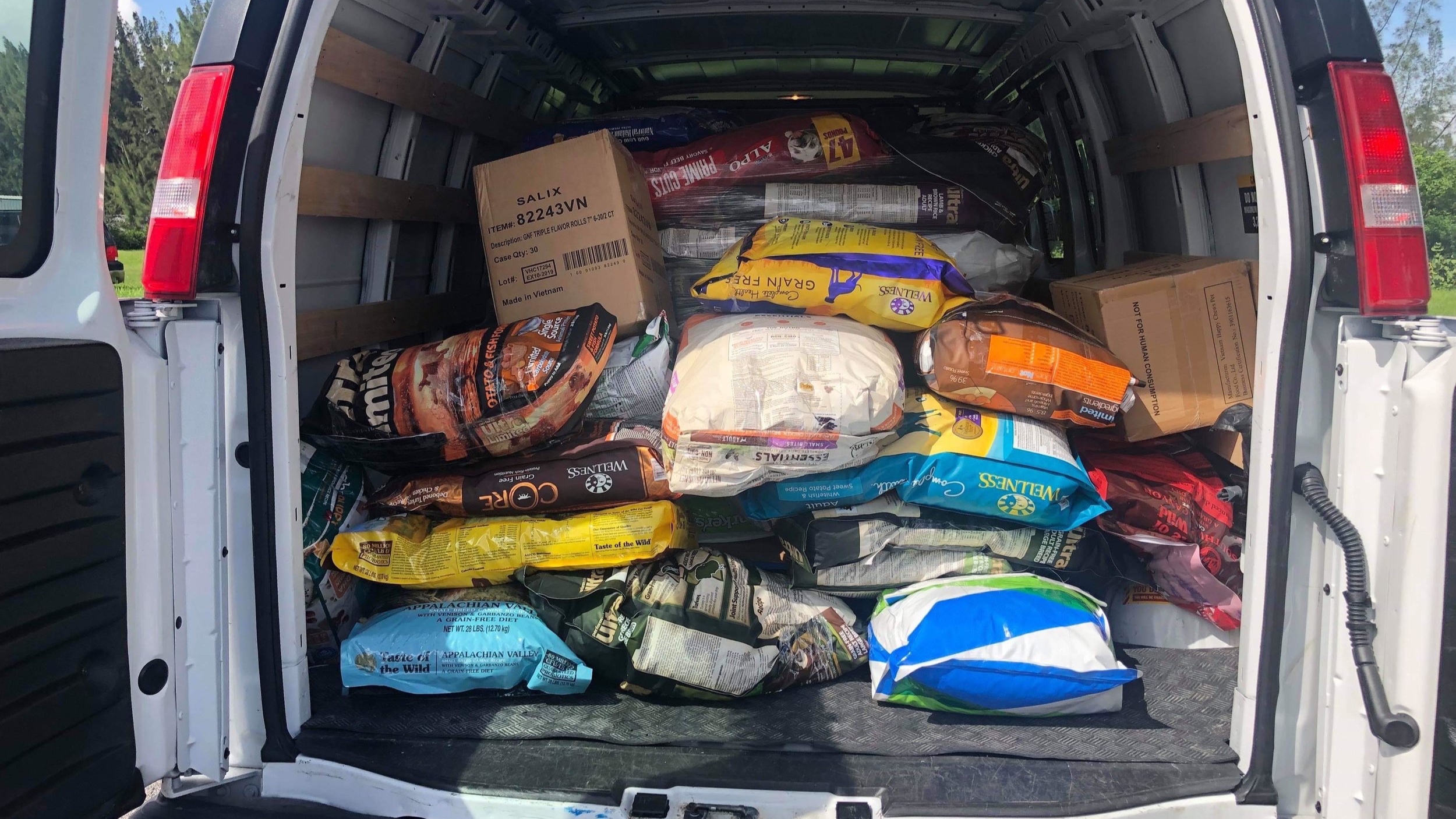Florida in 48: A Weekend Road Trip
Hotel, restaurant and beach deets!
Like many people in the U.S., we made the most of the long weekend this Memorial Day and decided to hit the road for a little fresh air, change of scenery, and fun in the sun before it gets screamingly hot here in Florida.
I would call this a semi-planned trip. I had it book marked in my brain but then my husband got sick and I had a ton of work to do, so I wasn’t sure we’d make it out (thankfully, he was fine and it was nothing COVID-related). But, at the last minute I decided to just go for it. Knowing full well it might be hard to find pet-friendly accommodations last minute AND for a holiday weekend, no less. But, if there’s anyone who’s up for a challenge, it’s me!
Our itinerary: We had certain places in mind that we wanted to visit, but we casually headed up the east coast of Florida and then across to the west coast.
Where we stayed: La Quinta Inn & Suites in Cocoa Beach, FL and Springhill Suites by Marriott in Ocala, FL Both are pet-friendly and do not have breed or size restrictions.
Pet fees: $75 and $30 per stay, respectively.
A little background: It’s been awhile since I’ve traveled with dogs. Mostly because the two I’ve had in the past few years were reactive and it just made navigating crowds and new spaces stressful for everyone. Add the heat and long car rides and we just opted to let them stay home. After the loss of our boy Lobo last year, we adopted Mr. Max back in October and he’s proven to be a great road dawg. But, because we’re still getting our sea legs, I have not yet perfected the practice. So, I welcome any and all your ideas and suggestions!
Packing for pups: For Christmas last year my dogs got their own suitcase. Yes, you read that right. At the end of 2020 we bought a camper and last year we took our first camping trips. I realized quickly that two large dogs need their own bag, lol. So for the holidays, I found a great rolling suitcase on Chewy, similar to this one and put it under the tree for them. :)
For hotel trips, I don’t have to pack as much, but as a minimum, I pack their food in individual Ziploc bags, separate bowls for water and food (their suitcase came with two collapsable ones), at least one large towel, treats, a favorite toy and a few emergency meds (e.g Trazadone, Imodium, a general antiseptic/hot spot spray and an ace bandage.) If you have it on hand, I also recommend taking along an anti-nausea drug like Cerenia which can help with car sickness. I also fill an old ice tea jug with water to keep in the car for water breaks. You can easily refill it at any hotel or restaurant stop.
Cocoa Beach, Florida
After driving for hours the first day we stopped in Cocoa Beach at this cute little Puerto Rican restaurant I found on Trip Advisor (basically during my bedtime search the night before). Besides just being super friendly, the staff at The Tiny Turtle were so sweet and accommodating to Max. It seemed like a never-ending flow of wait staff came out on to the patio to visit him once news got around inside. Anyway, I had a shrimp wrap and my husband had the tacos and Max had a plain patty from the kid’s menu. Everyone was a happy camper!
“We heard we have to pay the Max Tax before leaving”
After lunch, we checked into our room at La Quinta - Cape Canaveral. I can’t really rave about the accommodations here (you’re paying a premium for being a block away from the beach in a tourist town), but there were definitely some pros - 1. Friendly staff and super easy check-in/check out. 2. You can park directly in front of your room for easy access in and out. This is particularly helpful if you have reactive or anxious pets. 3. There was a big, empty field right across the street which was perfect for uninterrupted walks and potty breaks. 3. We were across the street from a dog park (look for Lori Wilson Park).
Disclaimer: I personally don’t use dog parks, but I know many do and in a pinch, sometimes you need one to burn off some energy.
After freshening up and doing a lap around the field we walked over to a local ice cream shop for a cold treat. When the kid behind the counter saw my husband waiting outside with Max he told me to have them come on in! Not only did they not mind having the dog in the shop, they ran to make him a pup cup of his own. Free of charge and with some head pats thrown in:)
(They also had what appeared to be a really cute patio out back to hang out on, but we skipped it because it looked like it was about to rain any minute. Hey, hey #floridasummers)
Crystal River, Florida
The next morning we grabbed some breakfast at the hotel and made an early exit so that we could west head across the state to the Crystal River area (this central coast town is part of a larger area dubbed Florida’s Nature Coast and if you’re not familiar with it I highly recommend checking it out). This chill little town is probably best known for its crystal clear (and highly protected) spring waters and park land that become the official home to manatees in the winter. The manatees congregate here by the hundreds in search of the warmth that the springs offer. Visitors can visit, feed, and even swim with them at designated times and locations. (I haven’t done that yet, but it’s definitely on my list!) We’re past manatee season now, but with summer’s high temps there’s plenty of casual, beachy relaxation to be had.
You can park hassle and fee-free right off the tiny main street of Citrus Ave., use (clean!) restrooms and take a stroll around the big grassy lot (complete with water fountains for people and dogs). We stopped for another late lunch at Kane’s Cattle Co., a steakhouse with a large patio. The food was great and they brought a plastic bowl and a big bottle of cold water for Max to enjoy while we sat outside. After lunch, we strolled down to Hunter Springs Park, watched some people enjoy the beach and load their kayaks into the water.
We loaded ourselves into the air conditioned car and headed to Ocala, about 30 min inland to check into the Springhill Suites. We welcomed the easy check-in and nice large room. Note: They have designated pet-friendly rooms, but the onus is on the guest to let them know at check-in that you’ll need one. Otherwise, you can incur a $250 cleaning fee. Yikes.
A few cons: There really isn’t anywhere to walk dogs, despite their website saying they have a dog “trail” somewhere. You’re right next to a large gas station and a busy road so make sure you have a good leash or secure system for taking them out if you stay at this particular location.
Homosassa, Florida
The next day we explored Homosassa, an old fishing village known for having tons of wildlife, water and boat activities, and the Ellie Schiller Wildlife State Park. After working up an appetite, we stopped at the Florida Cracker Kitchen, across from the historic Monkey Island attraction. We didn’t visit the monkeys (because of the dog and the heat, we skipped this), but we did enjoy a FANTASTIC brunch at this little restaurant across the water. It sits right on the dock where you can watch the boats go by. The menu was filled with yummy country kitchen options and the waitstaff was amazingly friendly. We talked with one of the waitresses about her own experience with German Shepherds and the cook even came out to greet Max and ask if he ate “people” food. Lo and behold, this sweet guy came out the back door with a doggie platter - an egg scramble with ham, sausage and bacon! What a kind gesture. He told us, “My daughter has a German Shepherd and she would never forgive me if I didn’t offer him a good meal!” They also brought us a water dish and plenty of cold water with ice. Besides leaving with full bellies (and a to-go bag), we have some great memories of this quaint and unique spot and would definitely return in the future (and hopefully see some monkeys).
As always, vacations seem too short, but it was time to get on the road and head back home. It was a great quick, getaway from our daily routines and schedule. Max slept for the next 24 hours - the adventurous life wears him out!
Side note: I feel compelled to mention that a lot of the beaches we visited didn’t allow dogs. Understandable for a few reasons, but still kind of a bummer. We got close, walking right up to the sand a few times and no one ever stopped us or gave us a warning, but it’s still important to know that you could be stopped and possibly fined.
That being said, we were blown away with how friendly - and pet-friendly - these small towns were. Everyone had a smile and lovely greeting. We joked that we could never be low-key and just keep to ourselves on a trip with Max - he is a people magnet!
I hope you found our little story inspiring and /or helpful in planning your next trip. I welcome your thoughts and comments - and of course, any of your recommendations for pet-friendly travel!
Life is Better With a Dog: How to Find the Right One for You
At Kibble & Dribble, our commitment to helping people and pets starts at the very beginning of the relationship. While (puppy) love at first sight is possible - it’s usually not an indicator of success or, guarantees a fairytale ending.
The decision to get a new dog isn’t an easy one; there are many factors to consider - cost, time, breed choices, lifestyle realities, etc. Often, people turn immediately to sites like Petfinder or Craigslist, but are quickly overwhelmed or disillusioned with their choices. Rest assured that those are not the only viable options out there.
We’ve broken down the various methods of dog adoption that are available and accessible to the general public, and the pet sources you should avoid.
Pet Stores: how much is that doggie in the window?
The short answer: don’t even bother asking. Large chains like Petland have been growing in popularity, but while they may appear stylish and trendy - BUYER BEWARE. Pet store dogs are usually supplied by large breeding operations, aka puppy mills. Dogs go from mills to stores across the country via third party dog brokers, who collect a fee for supplying a steady stream of “inventory.” Female dogs kept at mills are bred over and over again, while the litters are disseminated. This video by The Dodo does a great job of explaining the realities.
Once in the care of the store personnel, pups rarely get the vaccinations and/or medical attention they need, and then go home with unsuspecting customers who often have to follow up with extensive veterinary care. Finally, when those cute puppies start to age, the clock begins to tick. It’s not easy to keep as many full-grown dogs in a store (and also, people like to see those cute puppy faces), so those dogs….. “go back.” Yikes.
Recent legislation has banned the sale of animals in certain states and requires that pet stores get their animals from shelters or rescues.
New York State Senator Michael Gianaris and Assembly member Linda Rosenthal have introduced ASPCA-supported legislation to prohibit the sale of dogs, cats and rabbits in pet stores.
My new legislation to ban the sale of dogs, cats and rabbits in pet stores statewide will finally end the puppy-mill-to-pet-store pipeline. Animals such as puppies, kittens and bunnies in mills live short, tortured existences; their offspring, usually the animals offered for sale at pet stores, are often riddled with congenital issues as a result of the poor conditions and breeding practices employed,” said bill sponsor Assembly member Rosenthal. “Unsuspecting customers pay thousands of dollars for a cute puppy or kitten, only to find that the animal is incurably sick. By ensuring that pet stores can offer only rescues for adoption, this legislation will protect consumers and help to shut down the mills. Our animal shelters and rescue organizations are overflowing with animals needing forever homes; it's time we start connecting rescue animals with loving homes through adoption in pet stores.
Public education is critical in ensuring that we slowly eradicate these inhumane forms of breeding and selling. As hard as it is to resist those cute faces in the window, every sale goes to perpetuating the cycle of cruelty. The only way to stop it is to put pet stores out of business - if the demand dwindles, so will the supply.
Breeders - the good, the bad, and the ugly
Getting a dog from a highly reputable breeder is a great option, but be prepared to do some thorough research and pay a significant price. This is fair and reasonable considering the time, effort and cost of raising healthy, well-cared for, and socialized animals. If you are not prepared to spend between $2K and $5K, examine the myriad of adoption methods. And, despite the long-held belief that purebreds are the superior choice, it doesn’t necessarily guarantee a dog’s personality type or perfect health.
If you prefer to take this route: here are a few key indicators of a quality breeder:
Transparent and welcoming: Are you allowed to visit their facility and see their dogs? If this is geographically possible for you, we highly recommend you go. If they balk or make excuses for you not to come, that’s a red flag.
Age appropriate releases: A puppy should never be released to their new owner before12 weeks of age. Additionally, if a breeder has available litters too often you know that they are overbreeding their female(s), or running a large operation for maximum profits.
Strict return policy: A good breeder will ALWAYS allow you to return a dog. No matter what. In fact, they will require it and often will ask you to sign paperwork agreeing to it.
PROS: In the best case scenario, a breeder can provide you with a gorgeous, even-tempered animal in optimal health. Jakoba German Shepherds is a good example of what you should see when researching breeders.
CONS: While highly reliable, good breeders are costly and you can be on a waiting list for several months, or even a year, so be prepared. Beyond that, the sad fact is that the majority of breeders are not great, or scrupulous. Bad and over-breeding can result in genetic and behavioral issues. Backyard breeders are known for keeping animals in horrible conditions, not doing the necessary health testing and in some cases, hoarding. Backyard breeding is responsible for the significant number of animals that find themselves in the shelter system each year.
To rescue, or not to rescue
The most common questions and concerns when it comes to rescue are: Will I get a damaged dog? An abused dog? A dog with separation anxiety or aggression issues?
You might. You also might not. The term “rescue dog” conjures up images of sick, abused or senior animals, which is sometimes the case, but in reality, the majority are just dogs that need homes and were lucky enough to go into rescue instead of a shelter. Many times the owners simply could no longer care for them due to financial hardship, an expanding family, or illness. You’ll find many bouncy, happy go lucky dogs in rescue, and you will also find “special cases.”
Much like breeders, not all rescues are created - or operate - equally. You need to do your homework and read their reviews, meet with some volunteers, and ultimately, go with your gut. Rescues routinely have adoption events that will allow you to talk with volunteers, meet a variety of dogs and ask questions. They also offer 1:1 “meet and greets” if you are interested in one in particular and a detailed assessment of that dog’s temperament and personality.
Additionally you can expect:
An application process that may include a home check. They should ask all potential adopters to fill out an application. Don’t balk at this process, they are ensuring that the animal is going to a good and safe home.
Spaying/neutering/vaccinations. They should provide you an animal who is already fixed, vaccinated, and free of fleas and ticks. They should have also tested for heart worm (if that applies to your area) and stomach worms. These are non-negotiables.
Strict return policy. Just like a breeder, a good rescue should be willing to take a dog back if you can no longer care for them.
PROS: Rescues can be wonderful resources. Often, they have their own communities of really helpful owners and volunteers who want to see you succeed. They will make themselves available for your post-adoption questions and offer training suggestions. Their fees are generally lower than than breeders, but higher than Humane Societies or city shelters. You are getting a dog that’s been assessed, medically treated and vaccinated.
CONS: Not every rescue has enough staff or resources to provide the best services. Because of this, potential adopters may get incorrect information about a dog, or have to wait while the organization slogs through multiple applications for the same dog. Furthermore, you might not always be the chosen adopter as it is up to their discretion. The Washington Post explained just how daunting this process can be.
Plot Twist: breed-specific rescues
Westside German Shepherd Rescue is a popular rescue organization based in Los Angeles, CA.
A personal favorite of mine is the breed-specific rescue. Many people don’t know these even exist! Whether you have your heart set on a Great Dane or a Goldendoodle - there’s a rescue group for that.
PROS: Volunteers are usually extremely knowledgable about that particular breed. Their community is as well and can be a wealth of helpful information. I have met some really awesome people through the rescue community, many of whom I now consider personal friends.
CONS: The population and availability of certain breeds varies dramatically around the country. The rescue you find may be out of state or might not have any available dogs that fit your criteria. Most groups will however, agree to contact you in the future and can even arrange transportation for an additional cost.
Animal Shelters and Humane Societies:
the underdogs
The sad reality is that there are hundreds of thousands of dogs in shelters across the United States. Owner surrenders, strays, criminal confiscations - you name it, the shelter gets it. The pet overpopulation is largely due to backyard breeding (see above) and owners who do not spay and neuter their pets. There are amazing purebred dogs who end up in shelters, and there are mangy street mutts. They are all deserving of a home.
PROS: Perhaps the most altruistic, cost-effective and quickest option, adopting from a shelter can take as little as an hour and cost under $100.
CONS: Often understaffed, you will get little help once you step into a shelter. It’s up to you look at dogs and try to assess their temperament or personality - a difficult task in the shelter environment. The dogs have theoretically all been seen by medical staff, however, these vists are often rushed and shelter employess can often overlook, misdiagnose or simply not treat conditions deemed too costly. If you do adopt from the shelter, we recommend that you head immediately to your own vet for a checkup and a flea and tick bath.
The Dark Web
Craigslist and Facebook Groups are popular for people looking for free or low-cost pets. While some animals are listed innocently, these sites are commonly used by backyard breeders, dog fighters and dog-nappers. Need I say more?
This Dogster article written by a trainer details some of the things to look out for, specially on Craigslist and refers to it as an “adoption agency with no standards or oversight.” Pretty accurate. Still not convinced? Here’s another horror story.
The Obsession with Puppies
I feel compelled to address this here as a side note. Puppies are humans’ collective salve for the soul. Instagram has amplified the cuteness 1000x over sending images of those round bellies and clumsy gallops all around the world instantaneously. We have fallen in puppy love, and fallen hard. But, much like babies, they are a lot of work.
Puppies are available via all the adoption methods mentioned above. HOWEVER, bringing one home requires a lot more patience and flexibilty.
Important things to keep in mind if you want a puppy and think you’re ready:
A puppy should be at least 8 weeks old. Any younger is too young to be separated from mom.
Training puppies is incredibly difficult. We’re talking house breaking (which can require you to get up several times during the night), leash walking and obedience training.
We like to joke that the number of people who can successfully train a puppy train is akin to the number of people who will successfully train for and run, a marathon. In other words, not many. You need to be realistic about what you can commit to and accomplish as you will be in training mode for a solid 6 - 12 months. It’s definitely not for the faint of heart, but it is do-able. If you have the time and dedication to attempt this, I salute you!
“Keep in mind that a dog can take anywhere from a few days to a few months to settle in to your home. Prepare to clear your schedule and stay home with them for the first few days to help them adjust to their new surroundings and minimize the chance of any bathroom accidents or destructive behavior.”
We hope this breakdown gives you better understand of your options and empowers you to make an informed decision about your personal path to pet ownership. All of these methods can be extremely rewarding, but it helps to know what you are looking for and be realistic about what you can handle.
If you’d like a deeper understanding of any of these suggestions or additional help navigating the options, reach out to us at info@kibbleanddribble.com. Or, check out our consulting service The Pawfect Match which offers hands-on help to people and families in search of their perfect dog.
The Pawfect Match
As the owner and founder of Kibble& Dribble, I’m happy to announce that we are officially launcing our next venture, The Pawfect Match.
The Pawfect Match is a matchmaking service of sorts - designed to match people and families who are looking for a new pet, with their ideal match. In order to do that, we meet with new clients to determine their lifestyle, desired personality traits in a pet, family size and location. This happens either in person, if possible, or via a phone call. Our consultations typically last one hour and can be scheduled with anyone within the U.S.
“We offer comprehensive consultation services to help people figure out how and where to find their perfect pet. Our desire to help people and families through this process comes from a decade of seeing them struggle with analysis paralysis, frustrating wait times, unfamiliar costs, training issues, family dynamics and lifestyle changes.”
There isn’t just one right way to do it
We do not advocate for any one particular way of obtaining a new pet. Part of what I explain during consultations are the different, available routes you can take to pet ownership, and what to expect from each. From there, it will be your decision how to proceed. (However, we do not support, nor work with pet stores or unscrupulous breeders. This is not negotiable). Furthermore, we do not consider any breed “bad” or reliably “good.” There are variations within them all.
Dogs! They’re like potato chips….
Hi! I’m Vanessa Torres, founder of Kibble & Dribble and the Pawfect Match.
If you’d like to add a second or third pet to your home, we’d be happy to help you find your new addition! Part of our initial meeting will be getting to know your current pet(s) and determining what would be best for them, as well as the human members of the family.
We offer different packages to provide you with options that suit your timeline and budget.
The goal is to find your new best friend and to set you both up for success, preparing you for years of loyalty, commitment and enrichment.
Furthermore, our relationship with clients doesn’t simply end when your pup is home. If you have additional questions or concerns post-homecoming, we’re here to address them.
For more information visit our dedicated page, The Pawfect Match, where you’ll also find testimonials from people I’ve worked with. You can also join our Facebook page, where you’ll find current listings of dogs in need of new homes. I look forward to being your guide on this journey!
South Florida Animal Rescues Provide Aid to Bahamian Neighbors
Hurricane Dorian left the Bahamas with catastrophic damage
As the news and images began coming in over social media during what would normally be a celebratory holiday weekend, it became clear that the damage caused by Hurricane Dorian would be catastrophic.
While the entire state of Florida was placed under a state of emergency and coastal residents braced for the worst themselves, they watched in horror as the Bahama Islands were pummeled by a record-breaking Category 5 storm. After a brutal 48 hours with almost no communication, the desperate pleas for help started to emerge.
As a result, many Floridians are reaching out to help. Several local animal rescues and volunteers have mobilized to begin collecting supplies to send over, as well as make arrangements to bring back surviving dogs and cats.
Bullies n Beyond, Paw Patrol and South Florida Lending Hands are all animal rescues teaming up to support the North Abaco Potcake Rescue. They started collecting on Thursday and have already received much needed supplies. The plan is to charter a flight to bring it over, but they are still waiting to hear where they can land safely.
Due to the wait, the donations need to be stored somewhere safe, and the orgs have obtained a storage facility to hold the goods until they be safely delivered. Once it’s dropped off, the plane can be filled with dogs, who will be cared for by local fosters until they can be adopted out to new homes.
“We have a cargo plane lined up (and reserved) to assist us! They will transport 2,500lbs of supplies to the Bahamas. We just need to wait till the airport gives us the green light. Flight will be departing from FLL.” - Vicki DeLuca, Bullies -n- Beyond
As of Friday, 9/6/19 the most dire supplies needed are bungee cords, battery operated fans, batteries and rubbing alchol.
Monetary donations are critical in order to ensure they can charter enough flights necessary (fuel, insurance, etc) maintain the storage unit and provide care for the incoming dogs.
You can use paypal - BulliesnBeyond@gmail.com
If you are interested in fostering one of the incoming dogs, contact BulliesnBeyond@gmail.com.
“We have been working NON-STOP to make this happen but we can’t do it alone, we need help.”
The Great Bear Rainforest
Now at IMAX Theaters
Tucked away on Canada’s remote Pacific Coast is the Great Bear Rainforest, home to an array of wildlife including the white “Spirit Bear,” the rarest bear on Earth. It is the larget temperate coastal rainforest in the world and has remained relatively unchanged for more than 10,000 years under the careful care of the indigenous First Nations people. It is now the subject of a new documentary, The Great Bear Rainforest, showing in 3D at IMAX theaters across the country.
Director Ian McAllister - who has lived and worked in the area for 30 years - and his crew spent three years filming throughout the remote reaches of the forest, and captured the ocean world, the salmon river valleys, and the ice-capped peaks of the Coast Mountains. Their unprecedented footage of the Spirit Bear, grizzly and black bears, sea otters and humpback whales is breath-taking.
“The Great Bear Rainforest is one of the last truly wild places left on Earth, and has immense value both ecologically and culturally. Many people don’t know about this ancient rainforest and the indigenous people who have helped protect it for thousands of years.”
A Spirit Bear
The filmmakers shot four terabytes of film over three years in order to capture the dramatic landscape that ultimately fills 40 minutes of compelling story. The Black bears in this region are genetically different from those found in other parts of the country; with a genetic mutation occuring in some that has caused the fur to turn white. The light color camoflauges the bear while hunting for salmon - the predator virtually disappears against the cloudy sky, resulting in a much geater catch :)
This region has had the longstanding benefit or remaining relatively untouched for thousands of years, but global warming and logging has started to take it’s toll. Another problem for Grizzly bears in particular, is the sport of trophy hunting. With the help of First Nations, however, a ban on such hunting has been put in place, with the support of the local government.
The Great Bear Rainforest is narrated by actor Ryan Reynolds with a score by Academy Award winning composer Hans Zimmer. Director Ian McAllister is a co-founder and Executive Director of the wildlife conservation organization Pacific Wild. He is an award-winning photographer, filmmaker and author of nine books. He is also a Fellow of the International League of Conservation Photographers and the Royal Geographical Society.
You can learn more about the film - and watch the trailer - at Great Bear Rainforest Film. Prints of the images shared below can also be purchased at Pacific Wild. All photos are courtesy of Ian McAllister.










Special thanks to AutoNation IMAX Theater at the Museum of Discovery & Science.
From the Meat Trade to Loving Homes
Rescue + Freedom Project
Four lucky pups arrived in Los Angeles last week, rescued from the horrific South Korean meat trade. Getting dogs out of the most dangerous circumstances is the main mission of Shannon Keith, founder of Rescue + Freedom Project.
For about a year now, she and her organization have been focused on getting dogs out of China and Korea, where the dog meat trade is thriving. It’s hard for Westerners to imagine, but in certain Eastern communities, dog meat is highly valued and is often traded and served in a sort of underground or “black market.”
Freddie, May, Taylor and Johnnie arrived in Los Angeles on Jan. 18, 2019
Through the help and dedication of rescuers and volunteers on the ground locally, RFP is able to safely negotiate the release and transport of animals and help get them into loving foster homes in the U.S. This latest effort, dubbed “Bohemian Woof-soody” brought four dogs (named after the members of Queen) who are all just looking for someone to love, to Los Angeles, with the help of another non-profit, Koni.
No stranger to dangerous and high-profiile missions, Shannon became involved in animal rescue nearly ten years ago with the Beagle Freedom Project, whose main objective was rescuing dogs used for laboratory testing in the cosmetic and pharmaceutical industries. (Beagles became the dog of choice for many testing programs due to their friendly and docile nature). She started with one lab, and eventually grew it to include a network who were willing to agree to turn over dogs “when they were done with them,” instead of slating them for euthenasia.
Last week, the RFP had a crew on the ground to welcome these four sweet dogs - who were likely pets before being stolen and held on a meat farm - to their new homes in the United States. Watch the video below to see their arrival.
“Almost 9 years later, we are still getting animals out labs,” Shannon explains, “but we’ve also changed a lot of legislation and the consciousness. We are creeping slowly towards eliminating animal testing altogether.”
Watch as these four dogs arrive in Los Angeles and prepare for their new lives in loving foster homes. #happytails
Exploring the Alternatives: Eastern Medicine
Last year, we were hit with an unexpected flea infestation. In our nearly 16 years of owning our oldest dog, Finnigan, we’d never dealt with any flea problems before. My husband and I had just moved our family of three humans and two dogs from a 3,000 square foot home in the middle of the woods in northern Maine to a 1,000 square foot space in a Minneapolis suburb, seven minutes from the Mall of America. Somewhere between ME and MN, our dogs got fleas.
Our two terrier mixes were covered in them, and I had red bites all over my legs. My husband started looking for the best prices on flea shampoos, flea collars, and what needed to be sprayed where in order to nip the apartment infestation in the bud, and more importantly, keep it from happening again. I told him to wait… maybe we could try the homeopathic route? He side-eyed me, pointedly looked at my flea-bitten legs, and then reminded me that we had already tried the homeopathic/natural/holistic/Eastern route and that’s why we were in this mess.
I hated to admit it, but he was right. (Do not tell him I said that!) I had been relying on essential oils to prevent and repel fleas on Finnigan and Nibbler, spraying the couches and dogs with diluted homemade flea sprays, and was even using a homemade shampoo for their baths. The holistic and natural route has worked for us and our boys in certain respects - we give them charcoal bones or plain, pureed pumpkin for upset stomachs, plain low-fat yogurt for healthy skin and coats, and stick to grain-free, gluten-free dog foods for optimum health benefits. And at nearly 16, Finnigan is still jumping on and off our bed on his own, enjoys multiple daily walks, and our veterinarian and groomer marvel at how he’s still doing so well, so obviously, we’re doing something right. But this sudden flea infestation meant that natural wasn’t going to cut it.
“Buy what works,” I told him, and he did.
After a run to the stores, my husband arrived home with shampoo, collars, and a flea and tick prevention topical that works for three months for every application. It took two sets of three baths, a week apart, for our boys to be flea-free again. To rid the apartment of the infestation, we called our vet and used products she recommended. Essential oils, she said, might work for certain things, but homeopathy isn’t the answer for everything.
THE EXPERTS WEIGH IN
Dr. Alex Kintz Konneger, graduate of the University of Veterinary Medicine in Vienna, Austria and owner of the K. Vet Animal Care practice in Greensburg, PA, agrees. As pet owners, she says, it is in our dogs’ best interests for us to avoid getting stuck in all-or-nothing thinking. Our dogs are healthiest, Konneger says, when we incorporate both Western and Eastern philosophies into canine veterinary care.
Dr. Alex Konneger
“At K. Vet Animal Care we practice integrative veterinary medicine, which means we offer Western and Eastern medicine, chiropractic care, and physical therapy,” Konneger, 42, says. “This gives us more "tools in our toolbox" and the opportunity to select the optimal treatment choices for our patients. Both Eastern and Western medicine have their limitations, yet compliment each other harmoniously when applied correctly.” The most significant difference between Eastern and Western medicine (homeopathic or holistic and traditional, respectively) says Konneger, lies in the philosophies of each approach.
“Western medicine excels at the linear connections between cause and effect. If there is an infection - take your antibiotics. If there is a tumor - cut it out. It offers the opportunity to prevent diseases with vaccinations and certain medications (flea/tick/heartworm preventatives).” Konneger explains. “Yet, we define health basically as the absence of symptoms in Western medicine: "Your diagnostic tests are all normal, there is nothing wrong with you, you must be well."
But that, she adds, isn’t always the case.
“I would not want to practice a day without antibiotics or steroids or the option to perform surgery to save a patient's life,” Konneger says. “Still sometimes in Western medicine we seem to hit a wall and find ourselves without further valid options to improve the patient's quality of life. In Eastern medicine…We are not chasing a diagnosis of disease, we are analyzing patterns leading to the disease.”
Konneger and her staff believe that their integrative approach means choosing the best of both worlds of Eastern and Western Medicine, also incorporating into their core philosophy what is known as The Five Element Theory in Traditional Chinese Medicine. This theory holds that life force, or Qi, must flow freely between all five elements (organ systems). If there is a deficiency - or not enough Qi in one element, the patient will experience imbalance, disease, and potentially pain.
SENIOR SATISFACTION
Julie Katz Baker, the Adoption Coordinator for Shepherd Help & Rescue Effort in Boca Raton, Florida, also is a believer of integrative medicine. Her dogs, a 10-and a-half-year-old golden retriever named Kelsey, and a five-and-a-half-year-old German Shepherd named Journey, have both benefitted from utilizing traditional and holistic treatments.
Franzie receiving an acupuncture treatment at his vet
Kesley, says Katz Baker, has had positive results from acupuncture. Her old Golden Retriever, Buttons, Katz Baker adds, had Reiki treatments to treat her arthritis.
“Alternative treatments work” says Katz Baker. “Acupuncture seemed to help release the immediate pain.”
Pam S. of San Fernando Valley, CA, also owns German Shepherds. The 64-year-old says she loves veterinarians, but sometimes it’s necessary to use both Eastern and Western medicine. She also is a believer in the benefits of CBD oil.
“Timber is my shy, timid senior who, when we go to regular vets shakes all over, has to be coerced to go into a room but when we go to the holistic vet for treadmill underwater therapy or massage, laser, or chiropractic she doesn’t shake & she seems to relax,” Pam S. says. “My Franzie, who passed in April, was on all kinds of pain meds in addition to his holistic treatment, but I do believe he would have never lasted two-and-a-half-years after he became disabled if I hadn’t combined both services.”
“Eastern Medicine can help reduce the amount of medications commonly prescribed (like anti-inflammatories) long term, can be practiced with lesser side effects and is certainly less invasive in its approach. Same holds true for chiropractic care and physical therapy - enable the body to heal itself quicker.”
Dr. Konneger notes that it’s important to discuss options with your integrative practitioner whenever in doubt about how to proceed.
“All natural is not always the best or safest approach to any given situation.” Konneger adds that the excessive use of non-diluted essential oils is one example.
Essental oils can have a wide variety of applications for both humans and dogs, including nausea, digestive issues, anxiety, and parasite control.
“When applied topically at full-strength, these highly potent herbal extracts enter the blood stream, where they are metabolized by the liver, potentially resulting in liver stress or elevated liver function enzymes.” Konneger says, also adding that she strongly advises for year-round, regular flea, tick and heartworm preventatives.
“I get to teach at the Chi Institute for TCVM (Traditional Chinese Veterinary Medicine) in Florida several times a year and I am excited to see hundreds of veterinarians studying to become certified in acupuncture and herbal medicine,” Konneger says. “This makes my heart sing, as our pets are clearly going to benefit from us humans expanding our knowledge. In the long run this will hopefully lead to Eastern medicine not being a last chance hail Mary, but part of an integrative approach to both preventative medicine and disease treatment.”
Editor's note: Kibble & Dribble will be exploring this topic further in the future, as we believe alternative therapies will become an increasingly popular choice for pet owners, when feasible. If you have had a personal experience with trying homeopathic or natural remedies on your pet, please let us know in the comments (or send us an email!) and we might feature your story!












































